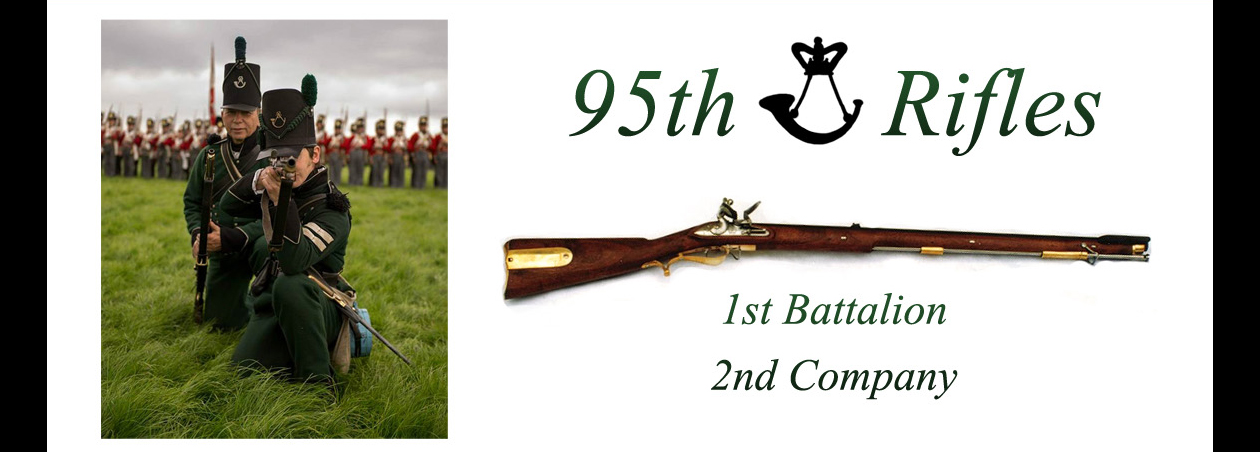This event is billed as the largest War 0f 1812 event in the country. This is not an idle boast. Not only is it a large event in terms of both reenactors and spectators, there are a huge number of sutlers in attendance.
The 1st Battalion was represented by Jim Tate, John Dittamo, Bill Goumas and Rich Miller. We joined the 3rd Battalion, 95th Rifles to form a company and a combined mess. There were three riflemen from the 3rd Battalion. We were joined in our mess by Captain Chris Black of the Royal Engineers. The ladies of the 3rd Battalion established a very complete and ornate mess. We ate a formal dinner each evening in a large marquee tent. Photos of the dinner meal can be seen on the “Photo Gallery” section of our web site.
Because of the number of riflemen we had, we were able to practice our company drill each day. In particular, we reviewed “Advance by Files from the Right”. Once in a column of twos, we practiced deploying from this formation into a line in front, to the right and to the left. These are all maneuvers that we must know for Waterloo 2020, so this practice time was important for us. Although Captain Black joined our mess, he was assigned to the British Indian Dept. I had to assume tactical leadership for the Rifles this weekend.
On Friday, there were over 4,000 school children from the surrounding school districts in attendance. The Friday battle was a reenactment of the original battle. It was an attack on an Indian village by the American Militia; and the next day’s counterattack by the Miami Indians. The British forces had only to watch, enjoy the battle, and the burning of the Indian village.
The highlight of Friday was the party at the camp of the US Rifle Regiment. This unit was celebrating its 20th anniversary at Mississinewa and we, as fellow riflemen, were invited to the celebration. The food and libations were excellent. It was a wonderful opportunity for the riflemen of each army to meet each other, exchange technical information about armaments, tactics and history and enjoy fellowship. In the battles of the next two days we were always opposite to the Rifle Regiment and we enjoyed taking shots at each other. It’s more fun when you recognize who you are shooting.
There were two battles each day on Saturday and Sunday. For each battle the stands were full of spectators. The scenario involved British and British Indians; Americans (both Regulars and militia) and American Indians. We altered the scenario in each battle to give each army a change to win a victory each day. There was a cavalry detachment that switched sides at each battle. We realized that whoever got the cavalry in that battle scenario was to win the battle. By having to rally into fours as the American Cavalry approached, we gained an appreciation for fast movement and swords! It was interesting that the cavalry would mistakenly circle our orbs in a counterclockwise direction. When a cavalryman circles an infantry group counterclockwise, they have to reach across their body to saber the infantry. Cavalry regulations required cavalrymen to carry their saber in their right hand. Thus, circling the infantry group in a clockwise direction allows for a greater reach with the saber. We received a compliment from the British commander after the last Saturday battle. He was very impressed with our tactical skill and organization and our performance as a unit.
In each of the battles we fired almost a cartridge box of rounds. Because I finally had my frizzen repaired and could fire regularly, I enjoyed firing 40 rounds in each battle.
Each morning at 9 AM the British battalion formed for “colors parade”. The colors were lowered each day at 5 PM. These ceremonies were highlighted by the formal raising or lowing of the British Union Jack and the pipe band playing “God Save the King”. We played a trick on the color party on Sunday by placing a box at the base of the flagpole to tease the color party who had a problem reaching the flag halyard on Saturday.
One of the main highlights of this event is the huge sutlers row in the encampment. The sutlers are lined on both sides of two roads for at least a mile. We all took the opportunity to visit these sutlers. I bought a flag holder for our company guidon. Now we can mark our company street with our guidon.
Saturday evening was an officer’s soiree at the camp of the American Commander, Steve Abolt. Visiting this social event was the President of St Bernard Parish (New Orleans) and several of his staff. They were visiting Mississinewa to understand the organization and planning involved in a major reenactment. They will sponsor the January 10-12, 2020 Battle of New Orleans event.
This event was held in very comfortable October weather. It was a fitting way to end the reenactment season for the 95th Rifles.
Respectfully Submitted,
James Tate
Sjt, 95th Rifles, 1st Battalion, 2nd Coy
